小矮人CoCo
---- 在这里看世界How to plant, grow and care for Rhododendrons
如何种植、栽培和护理杜鹃花
Rhododendrons are best known for their spectacular clusters of large, showy and often fragrant flowers. These are typically tubular, funnel, or bell-shaped and available in a range of colours spanning reds, yellows, pinks, purples and even white. Most rhodos flower in spring but there is also a growing range of summer flowering varieties perfect for adding charm and beauty to your garden, whilst deciduous azaleas also offer beautiful autumn foliage colour. Originating from the Himalayas, Rhododendrons have long been a mainstay of the woodland garden since being introduced into Britain by Victorian plant hunters. They are acid-loving shrubs, generally growing well in partial or dappled shade and combining well with the likes of Pieris 'Forest Flame' and Euphorbia 'Tasmanian Tiger'. There are a huge range of rhododendrons with over 900 varieties spanning low growing ground cover plants to specimens that can reach 6 metres tall. Larger varieties make great hedges, screens and foundation plants whilst dwarf alpines are highly effective in rock gardens and compact hybrids look excellent in containers positioned in a shaded spot of the garden.
杜鹃花以其壮观的大花簇、艳丽且芳香四溢而闻名。它们通常呈管状、漏斗状或钟形,有多种颜色可供选择,包括红色、黄色、粉色、紫色甚至白色。大多数杜鹃花在春季开花,但也有越来越多的夏季开花品种,非常适合为您的花园增添魅力和美丽,而落叶杜鹃花也提供美丽的秋季树叶颜色。杜鹃花起源于喜马拉雅山,自从被维多利亚时代的植物猎人引入英国以来,长期以来一直是林地花园的支柱。它们是喜酸灌木,通常在部分或斑驳的阴影下生长良好,并与“森林火焰”菜粉蝶和“塔斯马尼亚虎”大戟等植物很好地结合。杜鹃花种类繁多,有 900 多个品种,从低矮的地被植物到高达 6 米的杜鹃花品种。较大的品种可以制作出很好的树篱、屏障和基础植物,而矮高山植物在岩石花园中非常有效,而紧凑的杂交品种在放置在花园阴凉处的容器中看起来非常出色。
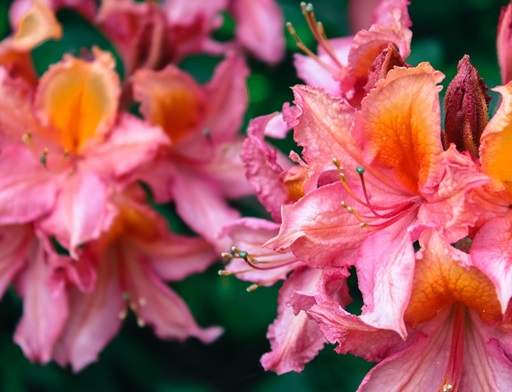
Pink rhododendron flowers with orange throats
粉红色的杜鹃花,橙色的喉咙
Rhododendron Planting Guide
杜鹃花种植指南
Finding the right location
寻找正确的位置
- Rhododendrons are a bit fussy, so it's worth spending some time to make sure you get the planting location right at the outset.
杜鹃花有点挑剔,所以值得花一些时间来确保从一开始就确定种植位置。
- Large-leaved varieties must have partial shade (a sunny spot that receives a couple of hours of shade in the morning and early afternoon is ideal) or dappled shade. On the fringe of an open tree canopy is good but avoid positioning rhododendrons in deep shade directly below a densely branching tree. Some shade in the height of the afternoon is particularly important for locations in the south of the UK that are a little hotter.
大叶品种必须有部分遮荫(理想的阳光充足的地方,早上和下午早些时候有几个小时的遮荫)或斑驳的遮荫。将杜鹃花放在开放的树冠边缘是不错的选择,但要避免将杜鹃花放置在浓密的树枝正下方的浓荫处。对于英国南部天气稍热的地区来说,午后的一些阴凉尤其重要。
- Azaleas are much more tolerant of full sun and in fact dwarf alpine varieties actively prefer it. However, it is still important to prevent the soil surrounding azaleas from drying out.
杜鹃花更能忍受充足的阳光,事实上,矮小的高山品种更喜欢阳光。然而,防止杜鹃花周围的土壤干燥仍然很重要。
- An acidic soil is essential, ideally humus-rich, moist yet free draining. If you have an alkaline soil, we recommend growing rhodos in a container, rather than trying to alter the acidity of your soil, which is not straightforward as the change is only temporary.
酸性土壤是必不可少的,最好是富含腐殖质、湿润但排水良好的土壤。如果您的土壤呈碱性,我们建议在容器中种植红花,而不是尝试改变土壤的酸度,这并不容易,因为这种变化只是暂时的。

If growing rhododendrons in containers, use an ericaceous compost
如果在容器中种植杜鹃花,请使用杜鹃花堆肥
- Rhododendrons don't like having wet feet; in fact, soggy, waterlogged ground is the most common cause of failure. If you have a heavy clay soil, plant your rhododendron in a mound of improved soil as described below. On the flip-side, rhododendrons do like lots of moisture so avoid planting under the eves of building were rainwater won't find it's way to their roots. Azaleas are a bit more forgiving of soil conditions but again acidity is key.
杜鹃花不喜欢湿脚;事实上,潮湿、积水的地面是最常见的故障原因。如果您有重粘土,请将杜鹃花种植在一堆改良的土壤中,如下所述。另一方面,杜鹃花确实喜欢大量的水分,所以避免种植在建筑物的前檐下,因为雨水无法到达它们的根部。杜鹃花对土壤条件的适应能力更强,但酸度也是关键。
- Avoid planting too close to large trees, hedges and shrubs which will steal moisture and nutrients from the surrounding soil, as well as walls and fences. Look at the eventual spread of your preferred variety to determine how much space to leave between your plants and surrounding objects in your garden.
避免种植得太靠近大树、树篱和灌木,它们会窃取周围土壤以及墙壁和栅栏的水分和养分。查看您喜欢的品种的最终分布,以确定您的植物和花园中周围物体之间应留出多少空间。
- Choose a location protected from strong, cold or drying winds and frost pockets. If your garden is particularly exposed, plant on the north side of a building or leeward side of a windbreak as flower buds are liable to dry out and die if they're left exposed. Rhododendrons will tolerate a more open site in less windy locations.
选择一个不受强风、寒冷或干燥风和霜冻影响的位置。如果您的花园特别暴露,请将植物种植在建筑物的北侧或防风林的背风侧,因为如果暴露在外,花蕾很容易变干并死亡。杜鹃花可以在风较小的地方种植更开阔的场地。

Rhododendron flower buds starting to open in the spring
杜鹃花蕾在春天开始开放
Garden Design & Spacing 花园设计与空间
- Rhododendrons look best when grown in groupings to create block colours. Grow groups of 3-5 of the same variety in loose drifts and choose an overarching scheme of around 3 colours if you have a larger area to plant up.
杜鹃花成群种植以形成块状颜色时看起来最好。在松散的土堆中种植 3-5 个相同品种的组,如果您有更大的种植面积,请选择大约 3 种颜色的总体方案。
- Check the eventual height and spread of your preferred varieties to determine how far apart to plant them. In theory plants should be positioned the same distance apart as their eventual spread, although it's possible to reduce this by up to 20% if you want more of an instant effect and/or want your plants to merge into blocks of foliage and flower colours over time. For example, for rhododendrons with an eventual spread of 2.5 metres, you could get away with planting 2 metres apart.
检查您喜欢的品种的最终高度和分布,以确定种植它们的距离。理论上,植物的放置位置应与其最终传播的距离相同,但如果您想要更多即时效果和/或希望植物在一段时间内融合成树叶和花朵颜色块,则可以将距离减少最多 20%。时间。例如,对于最终蔓延 2.5 米的杜鹃花,您可以间隔 2 米种植。
When to plant 何时种植
- Containerised rhododendrons can be planted at any time of the year but if you're able to choose, either October or between March and April is best.
集装箱杜鹃花可以在一年中的任何时间种植,但如果您可以选择,十月或三月至四月之间是最??好的。
- Autumn planting has the benefit of giving them time to settle in and grow new roots before winter, so they are well-established by spring and can really start putting on some growth.
秋季种植的好处是让它们有时间在冬季之前安顿下来并长出新根,因此它们到了春天就已经扎根,可以真正开始生长。
- On the other hand, by waiting until March-April you'll have the advantage of being able to see the colour and size of the flowers when you buy them (if you choose to visit our garden centre in Staffordshire to buy them of course).
另一方面,等到三月至四月,您在购买花朵时将有一个优势,可以看到花朵的颜色和大小(当然,如果您选择访问我们位于斯塔福德郡的花园中心购买它们) 。
- Plant at a time when the ground is not frozen or waterlogged and ideally when it's not excessively windy. If planting in the spring it's best to wait until all risk of frost has passed.
在地面没有结冰或积水的时候种植,最好是在风不太大的时候种植。如果在春季种植,最好等到所有霜冻风险过去。

Avoid planting rhododendrons when the ground is frozen or waterlogged
避免在地面结冰或积水时种植杜鹃花
Soil preparation 整地
- Before planting your rhododendron, start by clearing any perennial weeds and grass from your planting site.
在种植杜鹃花之前,首先清除种植地点的所有多年生杂草和草。
- Dig in plenty of ericaceous (lime free) compost or acidic organic mater into the soil. Good choices of materials are decomposing pine needles, composted tree bark, leafmould, chopped, composted bracken or peat substitute. Composted Christmas tree branches are also ideal. Do not use animal manure which is too strong for sensitive rhododendron roots or mushroom compost which is too limey.
将大量的杜鹃花(不含石灰)堆肥或酸性有机物质挖入土壤中。好的材料选择是分解的松针、堆肥树皮、腐叶土、切碎的、堆肥的蕨菜或泥炭替代品。堆肥圣诞树枝也是理想的选择。不要使用对敏感的杜鹃根来说太浓的动物粪便或太石灰的蘑菇堆肥。
- Rhododendrons are shallow and reasonably wide rooting so it's important to mix this well into the soil both at and around the planting site. You'll need to build in at least 10 litres of compost for dwarf rhododendrons and 20 litres for larger hybrids, even on good soils. For specimens work on the basis of 60 litres per plant.
杜鹃花的根系较浅且根系较宽,因此将其充分混合到种植地及其周围的土壤中非常重要。即使在良好的土壤上,您也需要为矮杜鹃树添加至少 10 升堆肥,为大型杜鹃花添加至少 20 升堆肥。对于标本工作,每株植物需要 60 升水。
- If you have an alkaline soil, one option is to increase the acidity of the soil using wettable sulfur or ferrous sulphate. Avoid using aluminium sulphate as it is toxic to rhododendron and azalea roots. At Jackson's Nurseries we actually advise against trying to make alkaline soils more acidic because it's not straightforward and any change will only last for a limited period with the natural alkalinity returning over time. Instead, grow a compact hybrid in container or install a raised bed, using a humus-rich ericaceous compost in both cases.
如果您的土壤呈碱性,一种选择是使用可湿性硫磺或硫酸亚铁来增加土壤的酸度。避免使用硫酸铝,因为它对杜鹃花和杜鹃花的根有毒。在杰克逊苗圃,我们实际上建议不要尝试使碱性土壤变得更加酸性,因为这并不简单,任何变化只会持续一段有限的时间,随着时间的推移,自然碱度会恢复。相反,在容器中种植紧凑的杂交品种或安装高架床,在这两种情况下都使用富含腐殖质的杜鹃花堆肥。
- If you're planting a full border, cultivate the whole area, rather than digging individual holes.
如果您要种植整个边界,请耕种整个区域,而不是挖单独的洞。

Pine needles are ideal for incorporating into the growing mix
松针是融入生长混合物的理想选择
How to plant a rhododendron
如何种植杜鹃花
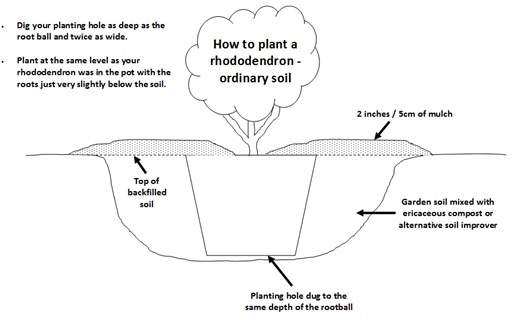
- Dig your planting hole as deep as the root ball and twice as wide. You will be aiming to plant at the same level as your rhododendron was in the pot with the roots just very slightly below the soil.
挖种植坑的深度与根球一样深,宽度是根球的两倍。您的目标是将杜鹃花种植在与花盆中的杜鹃花相同的高度,根部略低于土壤。
- Next, take the root ball out of its container and gently tease out any roots that may have started to circle around the base of the pot by pushing your fingers into the bottom edge of the rootball and pulling outwards. Doing this a few times will loosen the roots and encourage them to spread into the surrounding soil once planted. If roots are difficult to loosen by hand, make four shallow cuts into the root mass near the bottom with a sharp knife. This will promote growth into the surrounding soil.
接下来,将根球从容器中取出,通过将手指推入根球的底部边缘并向外拉,轻轻地梳理出可能开始围绕花盆底部旋转的任何根。这样做几次会松开根部,并鼓励它们在种植后扩散到周围的土壤中。如果用手很难松开根部,请用锋利的刀在靠近底部的根部切四个浅口。这将促进周围土壤的生长。
- Give your plant a brief soaking in a tub or bucket of water until the air bubbles disappear. Gently shake the root ball to allow excess water to drain off before positioning it in your planting hole.
将您的植物短暂浸泡在一盆或一桶水中,直到气泡消失。将根球放入种植孔之前,轻轻摇动根球,让多余的水排出。
- Planting too deeply, particularly in wet soils, will cause the roots to rot and invariably lead to failure. A good trick is to use a cane laid across your planting hole before backfilling to check the exact planting depth. If your plant sits too low, take it back out of the hole and add some soil back into the base. If it sits too high, dig your planting hole a little deeper. Again, the number one reason for rhododendrons failing is due to wet feet and this is most commonly caused by planting too deep so that lower stems are buried below soil level.
种植得太深,尤其是在潮湿的土壤中,会导致根部腐烂并必然导致失败。一个好的技巧是在回填之前用一根手杖横放在种植坑上,以检查准确的种植深度。如果你的植物位置太低,请将其从洞中取出并在底部添加一些土壤。如果它位置太高,请将种植坑挖得深一点。同样,杜鹃花失败的首要原因是脚湿,这最常见的原因是种植得太深,以致较低的茎埋在土壤水平以下。

Use a cane laid across your planting hole to check the planting depth
用一根手杖横放在种植坑上检查种植深度
- Next, start backfilling the dug soil, securing the soil around the roots with your hand as you go along. Once half filled, water well to settle the soil before continuing with the rest of the soil.
接下来,开始回填挖出的土壤,边走边用手将根部周围的土壤固定住。填满一半后,先浇水以使土壤沉降,然后再继续处理其余的土壤。
- Mulch with acidic material such as pine needles, bark or conifer clippings once complete, leaving a 2 inch (5cm) gap between the mulch and the base of your plants to reduce the risk of disease. Do not stand on or compress mulch - it should be kept well-aerated rather than packed down.
完成后,用松针、树皮或针叶树剪草等酸性材料覆盖,在覆盖物和植物基部之间留下 2 英寸(5 厘米)的间隙,以降低患病风险。不要站在或压缩覆盖物上——它应该保持通风良好,而不是压紧。
Planting Rhododendrons in a mound of improved soil in very heavy clay conditions
在粘土条件非常重的改良土壤中种植杜鹃花
- If you have a heavy clay soil, plant your rhododendron in a mound of improved soil above the base clay soil. This is required because if you dig a hole in very heavy soil and fill it back with a light soil mixture, you'll effectively just end up creating a bucket in the ground made of slick clay, which will hold too much water.
如果您有重粘土,请将杜鹃花种植在基粘土上方的一堆改良土壤中。这是必需的,因为如果您在非常重的土壤中挖一个洞并用轻质土壤混合物填满它,那么您实际上最终会在地面上形成一个由光滑粘土制成的桶,该桶会容纳太多的水。
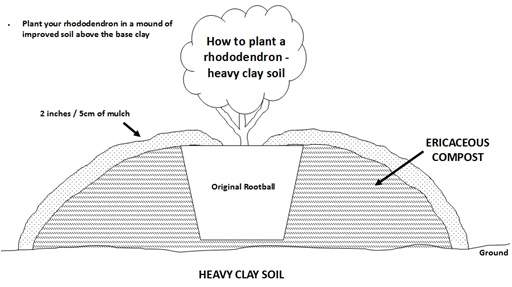
Rhododendron Garden Care 杜鹃花园护理
Weeding 除草
- Keep your rhododendrons clear of perennial weeds during the growing season. Weeds are best removed by hand rather than using a hoe which could damage the shallow roots of your plants.
在生长季节,让杜鹃花远离多年生杂草。最好用手清除杂草,而不是使用锄头,因为锄头可能会损坏植物的浅根。
Watering 浇水
- Rhododendrons are native to areas with high rainfall, so they are naturally suited to moist soils. They are also shallow rooting so won't compete with nearby deeper rooted plants for moisture. Watering will be required during prolonged periods of hot, dry weather in late spring, summer and early autumn.
杜鹃花原产于降雨量高的地区,因此它们天然适合潮湿的土壤。它们的根部也较浅,因此不会与附近根部较深的植物争夺水分。春末、夏季和初秋的长时间炎热干燥天气需要浇水。
- A rough guide is to water your plants if there has been less than 1 inch (2.5cm) of rain per week. Shade-loving annuals such as impatiens can be planted around or in front of your rhododendrons as companion plants to help indicate when water is needed.
粗略的指导是,如果每周降雨量少于 1 英寸(2.5 厘米),请给植物浇水。喜荫的一年生植物,如凤仙花,可以种植在杜鹃花周围或前面,作为伴生植物,以帮助指示何时需要水。
- Rhododendrons do not like the calcium from tap water in hard water areas as this neutralises the acidity of the soil. If you live in a hard water region, water your rhododendron plants with collected rainwater where possible.
杜鹃花不喜欢硬水地区自来水中的钙,因为这会中和土壤的酸度。如果您生活在硬水地区,请尽可能用收集的雨水浇灌杜鹃花植物。
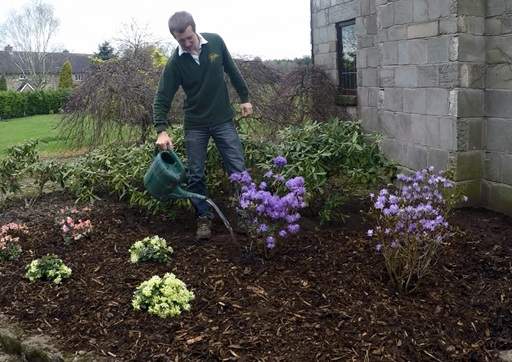
Mulching 覆盖
- Rhododendrons benefit from a generous mulch of pine needles or bark each spring. This has four key benefits:
每年春天,杜鹃花都会受益于大量的松针或树皮覆盖物。这有四个主要好处:
1) Helps to retain moisture by preventing evaporation from the surface of the soil
1) 通过防止土壤表面蒸发来帮助保持水分
2) Suppresses weeds around your plants which would compete for water and nutrients
2) 抑制植物周围的杂草,这些杂草会争夺水分和养分
3) Acts as insulation to protect the roots from harsh frosts in the winter
3)起到隔热作用,保护根部免受冬季严酷的霜冻
4) Provides a gradual stream of nutrients to your plants as it decomposes
4) 在分解过程中逐渐向植物提供养分
- Leave a 2 inch (5cm) gab between the mulch and the base of your plants to reduce the risk of disease.
在覆盖物和植物基部之间留出 2 英寸(5 厘米)的间隙,以降低患病风险。
- Do not use weed suppressing matting or gravel which prevents air from reaching the roots and impairs drainage.
不要使用杂草抑制垫或砾石,因为它们会阻止空气到达根部并损害排水。
Feeding 喂养
- Rhododendrons and azaleas should be fertilised sparingly because excessive applications can burn the roots.
杜鹃花和杜鹃花应少量施肥,因为过量施肥会烧伤根部。
- Sprinkle some slow-release ericaceous plant food around the base of your plants in early spring, just as the flower buds are starting to swell. As always, follow the instructions on the package but 70 grams (half a handful) per square metre is about right.
早春,当花蕾开始膨胀时,在植物基部周围撒一些缓释的杜鹃花植物食物。与往常一样,请遵循包装上的说明,但每平方米 70 克(半把)就比较合适。
- Avoid feeding rhododendrons with bone meal as it contains too much calcium.
避免给杜鹃花喂骨粉,因为骨粉中钙含量过高。
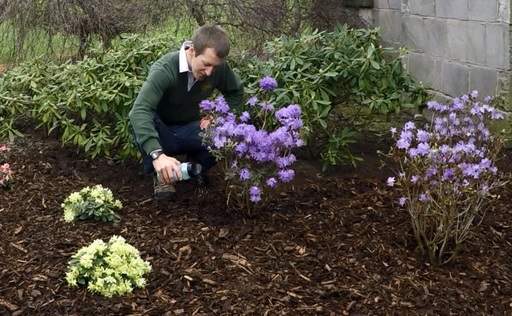
Feed rhododendrons with slow release ericaceous plant food
用缓释杜鹃花植物性食物喂养杜鹃花
Pruning 修剪
- Rhododendrons do not require any pruning other than to remove any dead, damaged and crossing branches.
杜鹃花不需要任何修剪,除了去除任何枯死的、受损的和交叉的树枝。
- The only other reason you might need to prune is to reduce the height and spread of your plants to within required bounds. It is much better if you can check the space you have available and choose a variety with an appropriate eventual height and spread at the outset because if you do need to prune an established bush heavily, it may not bloom again for two to three years.
您可能需要修剪的唯一其他原因是将植物的高度和蔓延降低到所需的范围内。如果您一开始就可以检查可用的空间并选择最终高度和分布合适的品种,那就更好了,因为如果您确实需要大量修剪已建立的灌木丛,它可能在两到三年内不会再次开花。
- If you need to reduce the size of your plants, prune after flowering has finished in the spring. Do this by making clean cuts using a sharp pair of secateurs. Feed with a slow release ericaceous plant food after cutting your plants back, if you haven't already.
如果您需要减小植物的大小,请在春季开花结束后进行修剪。通过使用锋利的剪枝器进行干净的切割来完成此操作。如果您还没有修剪植物,请在修剪植物后喂食缓慢释放的杜鹃花植物性食物。
Deadheading 死头
- Deadhead spent flowers once they have faded to help encourage a second flush of blooms. Deadheading also keeps your plants looking tidy and will prevent seed production once flowering is over, so your plants focus their energy on developing fresh leafy foliage instead.
一旦花朵凋谢,枯萎的花就会帮助促进第二次绽放。死头还可以让你的植物看起来整洁,并且在开花结束后会阻止种子的产生,因此你的植物将精力集中在长出新鲜的绿叶上。
- Remove flowers carefully as next year's flowering buds are immediately below the current season's flowers and if you cut them off by accident you'll have no display the following year. Do this by snapping off spent flower stalks by bending them over until they break away.
小心地摘下花朵,因为明年的花蕾紧邻当前季节的花朵下方,如果您不小心将它们剪掉,那么来年就无法再展示了。通过将花茎弯曲直至折断,将花茎折断。
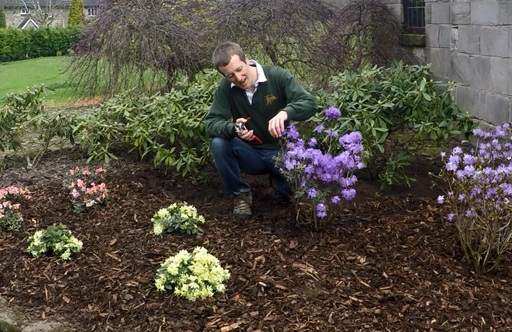
Deadhead rhododendrons with loppers or secateurs
死头杜鹃花与剪枝器或剪枝器
Cold Protection 防寒
- Rhododendrons are frost hardy in most of the UK with evergreens normally only requiring protection during severe winters. This can be achieved by wrapping a few layers of horticultural fleece around your plants.
在英国大部分地区,杜鹃花都具有耐寒性,而常绿植物通常只需要在严冬期间进行保护。这可以通过在植物周围包裹几层园艺羊毛来实现。
Problems, Pests and Diseases
问题、害虫和疾病
Moisture Issues 水分问题
- Leaf drop - leaves falling to the ground following a period of dry weather. Usually proceeded by the leaves starting to droop down and roll up.
落叶- 经过一段时间的干燥天气后,树叶掉落到地上。通常,叶子开始下垂并卷起。 - Bud blast - if your rhododendrons fail to flower successfully, the most likely cause is a lack of moisture the previous summer when the buds were starting to form. Dry conditions at this time will cause buds to fail or partially form then drop off.
花蕾爆发——如果你的杜鹃花未能成功开花,最可能的原因是前一个夏天花蕾开始形成时缺乏水分。此时的干燥条件会导致芽失败或部分形成然后脱落。 - Recommended Solution: Mulch to help retain moisture and water regularly during prolonged periods of hot, dry weather.
推荐的解决方案:在长时间炎热干燥的天气期间,覆盖物有助于定期保持水分和水分。
Insect Issues 昆虫问题
- Vine weevil - insects that can infest your plans and destroy the leaves. They develop from grubs which eat the roots.
藤象甲虫- 可以侵扰您的计划并破坏叶子的昆虫。它们是由吃根的幼虫发育而来的。
- Caterpillars - can infest rhododendrons and will munch through particularly large leaved varieties quite quickly.
毛毛虫- 可以侵扰杜鹃花,并且会很快咀嚼特别大的叶子品种。
- Leafhoppers - another form of insect that suck sap out of your plants, causing a pale mottling on the foliage.
叶蝉- 另一种昆虫,会从植物中吸取汁液,导致叶子上出现苍白的斑点。
- Scale insects - suck sap from your plants and excrete a sticky honeydew substance which often leads to the growth of black, sooty moulds.
介壳虫- 从植物中吸取汁液并排出粘性蜜露物质,这通常会导致黑色、煤烟状霉菌的生长。 - Recommended Solution: Treat with a bug killer spray.
推荐的解决方案:使用杀虫喷雾进行处理。
Fungus Issues 真菌问题
- Powdery mildew - a fungal disease causing a white or yellowish dusty coating over foliage, flowers and stems.
白粉病- 一种真菌病,会在叶子、花朵和茎上形成白色或淡黄色的灰尘涂层。
- Rust - one of the most common of garden diseases characterised by orange, yellow or brownish spots on leaves. Usually seen from mid- to late-summer and autumn.
锈病- 最常见的花园病害之一,其特征是叶子上出现橙色、黄色或棕色斑点。通常出现在仲夏末和秋季。
- Petal blight - another form of fungal disease that develops in flowers and is brought on by moist, damp conditions. Identified by brown flecks on petals that rapidly merge to form blotches and, if left untreated, will continue to engulf your flowers until they die and fall to the ground.
花瓣枯萎病- 另一种在花朵中发生的真菌病,由潮湿的环境引起。通过花瓣上的棕色斑点来识别,这些斑点会迅速融合形成斑点,如果不加以处理,将继续吞噬您的花朵,直到它们死亡并掉落在地上。 - Recommended Solution: Treat the affected areas with a fungus killer. If your plants have suffered from petal blight in a previous season, we recommend using a fungus killer as a preventative measure once a week from when the flowers open. Otherwise, by the time you've actually spotted the issue it'll probably be too late.
推荐的解决方案:用真菌杀手治疗受影响的区域。如果您的植物在上一季节遭受过花瓣枯萎病,我们建议从花朵开放后每周使用一次真菌杀手作为预防措施。否则,当您真正发现问题时可能为时已晚。
Comments 评论







